Jiangmeng Li
Self-Reinforcing Prototype Evolution with Dual-Knowledge Cooperation for Semi-Supervised Lifelong Person Re-Identification
Jul 02, 2025Abstract:Current lifelong person re-identification (LReID) methods predominantly rely on fully labeled data streams. However, in real-world scenarios where annotation resources are limited, a vast amount of unlabeled data coexists with scarce labeled samples, leading to the Semi-Supervised LReID (Semi-LReID) problem where LReID methods suffer severe performance degradation. Existing LReID methods, even when combined with semi-supervised strategies, suffer from limited long-term adaptation performance due to struggling with the noisy knowledge occurring during unlabeled data utilization. In this paper, we pioneer the investigation of Semi-LReID, introducing a novel Self-Reinforcing Prototype Evolution with Dual-Knowledge Cooperation framework (SPRED). Our key innovation lies in establishing a self-reinforcing cycle between dynamic prototype-guided pseudo-label generation and new-old knowledge collaborative purification to enhance the utilization of unlabeled data. Specifically, learnable identity prototypes are introduced to dynamically capture the identity distributions and generate high-quality pseudo-labels. Then, the dual-knowledge cooperation scheme integrates current model specialization and historical model generalization, refining noisy pseudo-labels. Through this cyclic design, reliable pseudo-labels are progressively mined to improve current-stage learning and ensure positive knowledge propagation over long-term learning. Experiments on the established Semi-LReID benchmarks show that our SPRED achieves state-of-the-art performance. Our source code is available at https://github.com/zhoujiahuan1991/ICCV2025-SPRED
Multi-Modal Learning with Bayesian-Oriented Gradient Calibration
May 29, 2025Abstract:Multi-Modal Learning (MML) integrates information from diverse modalities to improve predictive accuracy. However, existing methods mainly aggregate gradients with fixed weights and treat all dimensions equally, overlooking the intrinsic gradient uncertainty of each modality. This may lead to (i) excessive updates in sensitive dimensions, degrading performance, and (ii) insufficient updates in less sensitive dimensions, hindering learning. To address this issue, we propose BOGC-MML, a Bayesian-Oriented Gradient Calibration method for MML to explicitly model the gradient uncertainty and guide the model optimization towards the optimal direction. Specifically, we first model each modality's gradient as a random variable and derive its probability distribution, capturing the full uncertainty in the gradient space. Then, we propose an effective method that converts the precision (inverse variance) of each gradient distribution into a scalar evidence. This evidence quantifies the confidence of each modality in every gradient dimension. Using these evidences, we explicitly quantify per-dimension uncertainties and fuse them via a reduced Dempster-Shafer rule. The resulting uncertainty-weighted aggregation produces a calibrated update direction that balances sensitivity and conservatism across dimensions. Extensive experiments on multiple benchmark datasets demonstrate the effectiveness and advantages of the proposed method.
On the Transferability and Discriminability of Repersentation Learning in Unsupervised Domain Adaptation
May 28, 2025Abstract:In this paper, we addressed the limitation of relying solely on distribution alignment and source-domain empirical risk minimization in Unsupervised Domain Adaptation (UDA). Our information-theoretic analysis showed that this standard adversarial-based framework neglects the discriminability of target-domain features, leading to suboptimal performance. To bridge this theoretical-practical gap, we defined "good representation learning" as guaranteeing both transferability and discriminability, and proved that an additional loss term targeting target-domain discriminability is necessary. Building on these insights, we proposed a novel adversarial-based UDA framework that explicitly integrates a domain alignment objective with a discriminability-enhancing constraint. Instantiated as Domain-Invariant Representation Learning with Global and Local Consistency (RLGLC), our method leverages Asymmetrically-Relaxed Wasserstein of Wasserstein Distance (AR-WWD) to address class imbalance and semantic dimension weighting, and employs a local consistency mechanism to preserve fine-grained target-domain discriminative information. Extensive experiments across multiple benchmark datasets demonstrate that RLGLC consistently surpasses state-of-the-art methods, confirming the value of our theoretical perspective and underscoring the necessity of enforcing both transferability and discriminability in adversarial-based UDA.
CellCLAT: Preserving Topology and Trimming Redundancy in Self-Supervised Cellular Contrastive Learning
May 27, 2025Abstract:Self-supervised topological deep learning (TDL) represents a nascent but underexplored area with significant potential for modeling higher-order interactions in simplicial complexes and cellular complexes to derive representations of unlabeled graphs. Compared to simplicial complexes, cellular complexes exhibit greater expressive power. However, the advancement in self-supervised learning for cellular TDL is largely hindered by two core challenges: \textit{extrinsic structural constraints} inherent to cellular complexes, and intrinsic semantic redundancy in cellular representations. The first challenge highlights that traditional graph augmentation techniques may compromise the integrity of higher-order cellular interactions, while the second underscores that topological redundancy in cellular complexes potentially diminish task-relevant information. To address these issues, we introduce Cellular Complex Contrastive Learning with Adaptive Trimming (CellCLAT), a twofold framework designed to adhere to the combinatorial constraints of cellular complexes while mitigating informational redundancy. Specifically, we propose a parameter perturbation-based augmentation method that injects controlled noise into cellular interactions without altering the underlying cellular structures, thereby preserving cellular topology during contrastive learning. Additionally, a cellular trimming scheduler is employed to mask gradient contributions from task-irrelevant cells through a bi-level meta-learning approach, effectively removing redundant topological elements while maintaining critical higher-order semantics. We provide theoretical justification and empirical validation to demonstrate that CellCLAT achieves substantial improvements over existing self-supervised graph learning methods, marking a significant attempt in this domain.
CAIFormer: A Causal Informed Transformer for Multivariate Time Series Forecasting
May 22, 2025

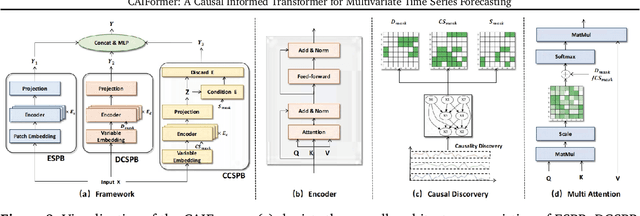

Abstract:Most existing multivariate time series forecasting methods adopt an all-to-all paradigm that feeds all variable histories into a unified model to predict their future values without distinguishing their individual roles. However, this undifferentiated paradigm makes it difficult to identify variable-specific causal influences and often entangles causally relevant information with spurious correlations. To address this limitation, we propose an all-to-one forecasting paradigm that predicts each target variable separately. Specifically, we first construct a Structural Causal Model from observational data and then, for each target variable, we partition the historical sequence into four sub-segments according to the inferred causal structure: endogenous, direct causal, collider causal, and spurious correlation. The prediction relies solely on the first three causally relevant sub-segments, while the spurious correlation sub-segment is excluded. Furthermore, we propose Causal Informed Transformer (CAIFormer), a novel forecasting model comprising three components: Endogenous Sub-segment Prediction Block, Direct Causal Sub-segment Prediction Block, and Collider Causal Sub-segment Prediction Block, which process the endogenous, direct causal, and collider causal sub-segments, respectively. Their outputs are then combined to produce the final prediction. Extensive experiments on multiple benchmark datasets demonstrate the effectiveness of the CAIFormer.
Rethinking the Bias of Foundation Model under Long-tailed Distribution
Jan 27, 2025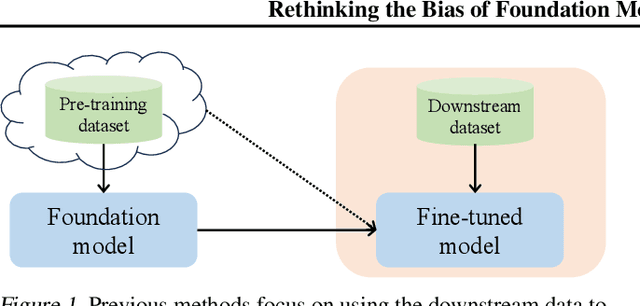
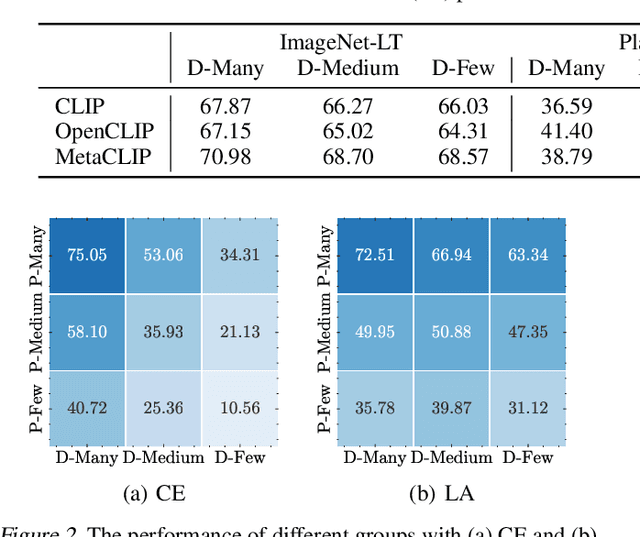
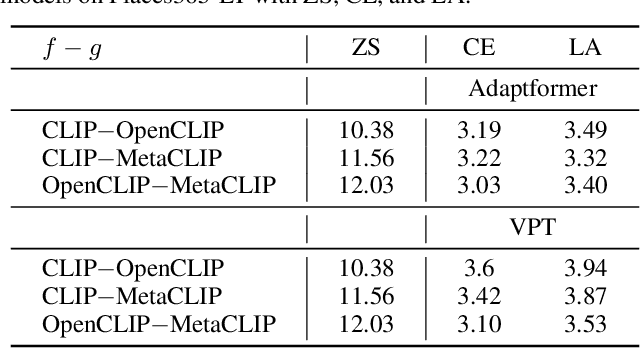

Abstract:Long-tailed learning has garnered increasing attention due to its practical significance. Among the various approaches, the fine-tuning paradigm has gained considerable interest with the advent of foundation models. However, most existing methods primarily focus on leveraging knowledge from these models, overlooking the inherent biases introduced by the imbalanced training data they rely on. In this paper, we examine how such imbalances from pre-training affect long-tailed downstream tasks. Specifically, we find the imbalance biases inherited in foundation models on downstream task as parameter imbalance and data imbalance. During fine-tuning, we observe that parameter imbalance plays a more critical role, while data imbalance can be mitigated using existing re-balancing strategies. Moreover, we find that parameter imbalance cannot be effectively addressed by current re-balancing techniques, such as adjusting the logits, during training, unlike data imbalance. To tackle both imbalances simultaneously, we build our method on causal learning and view the incomplete semantic factor as the confounder, which brings spurious correlations between input samples and labels. To resolve the negative effects of this, we propose a novel backdoor adjustment method that learns the true causal effect between input samples and labels, rather than merely fitting the correlations in the data. Notably, we achieve an average performance increase of about $1.67\%$ on each dataset.
Continual Test-Time Adaptation for Single Image Defocus Deblurring via Causal Siamese Networks
Jan 15, 2025



Abstract:Single image defocus deblurring (SIDD) aims to restore an all-in-focus image from a defocused one. Distribution shifts in defocused images generally lead to performance degradation of existing methods during out-of-distribution inferences. In this work, we gauge the intrinsic reason behind the performance degradation, which is identified as the heterogeneity of lens-specific point spread functions. Empirical evidence supports this finding, motivating us to employ a continual test-time adaptation (CTTA) paradigm for SIDD. However, traditional CTTA methods, which primarily rely on entropy minimization, cannot sufficiently explore task-dependent information for pixel-level regression tasks like SIDD. To address this issue, we propose a novel Siamese networks-based continual test-time adaptation framework, which adapts source models to continuously changing target domains only requiring unlabeled target data in an online manner. To further mitigate semantically erroneous textures introduced by source SIDD models under severe degradation, we revisit the learning paradigm through a structural causal model and propose Causal Siamese networks (CauSiam). Our method leverages large-scale pre-trained vision-language models to derive discriminative universal semantic priors and integrates these priors into Siamese networks, ensuring causal identifiability between blurry inputs and restored images. Extensive experiments demonstrate that CauSiam effectively improves the generalization performance of existing SIDD methods in continuously changing domains.
M2I2: Learning Efficient Multi-Agent Communication via Masked State Modeling and Intention Inference
Dec 31, 2024Abstract:Communication is essential in coordinating the behaviors of multiple agents. However, existing methods primarily emphasize content, timing, and partners for information sharing, often neglecting the critical aspect of integrating shared information. This gap can significantly impact agents' ability to understand and respond to complex, uncertain interactions, thus affecting overall communication efficiency. To address this issue, we introduce M2I2, a novel framework designed to enhance the agents' capabilities to assimilate and utilize received information effectively. M2I2 equips agents with advanced capabilities for masked state modeling and joint-action prediction, enriching their perception of environmental uncertainties and facilitating the anticipation of teammates' intentions. This approach ensures that agents are furnished with both comprehensive and relevant information, bolstering more informed and synergistic behaviors. Moreover, we propose a Dimensional Rational Network, innovatively trained via a meta-learning paradigm, to identify the importance of dimensional pieces of information, evaluating their contributions to decision-making and auxiliary tasks. Then, we implement an importance-based heuristic for selective information masking and sharing. This strategy optimizes the efficiency of masked state modeling and the rationale behind information sharing. We evaluate M2I2 across diverse multi-agent tasks, the results demonstrate its superior performance, efficiency, and generalization capabilities, over existing state-of-the-art methods in various complex scenarios.
Rethinking Generalizability and Discriminability of Self-Supervised Learning from Evolutionary Game Theory Perspective
Nov 30, 2024



Abstract:Representations learned by self-supervised approaches are generally considered to possess sufficient generalizability and discriminability. However, we disclose a nontrivial mutual-exclusion relationship between these critical representation properties through an exploratory demonstration on self-supervised learning. State-of-the-art self-supervised methods tend to enhance either generalizability or discriminability but not both simultaneously. Thus, learning representations jointly possessing strong generalizability and discriminability presents a specific challenge for self-supervised learning. To this end, we revisit the learning paradigm of self-supervised learning from the perspective of evolutionary game theory (EGT) and outline the theoretical roadmap to achieve a desired trade-off between these representation properties. EGT performs well in analyzing the trade-off point in a two-player game by utilizing dynamic system modeling. However, the EGT analysis requires sufficient annotated data, which contradicts the principle of self-supervised learning, i.e., the EGT analysis cannot be conducted without the annotations of the specific target domain for self-supervised learning. Thus, to enhance the methodological generalization, we propose a novel self-supervised learning method that leverages advancements in reinforcement learning to jointly benefit from the general guidance of EGT and sequentially optimize the model to chase the consistent improvement of generalizability and discriminability for specific target domains during pre-training. Theoretically, we establish that the proposed method tightens the generalization error upper bound of self-supervised learning. Empirically, our method achieves state-of-the-art performance on various benchmarks.
Neuromodulated Meta-Learning
Nov 11, 2024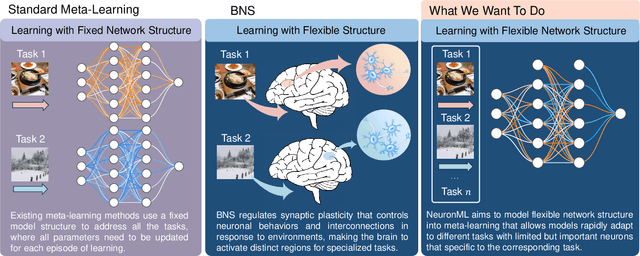
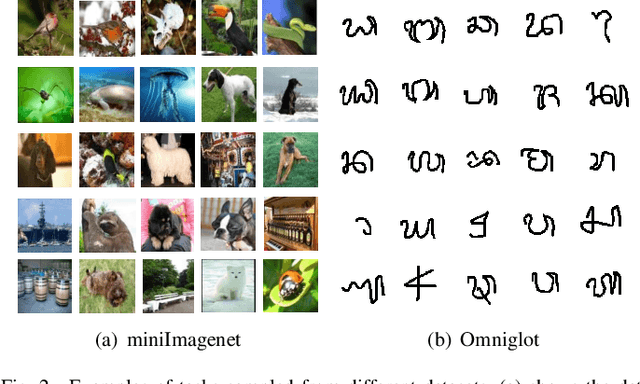
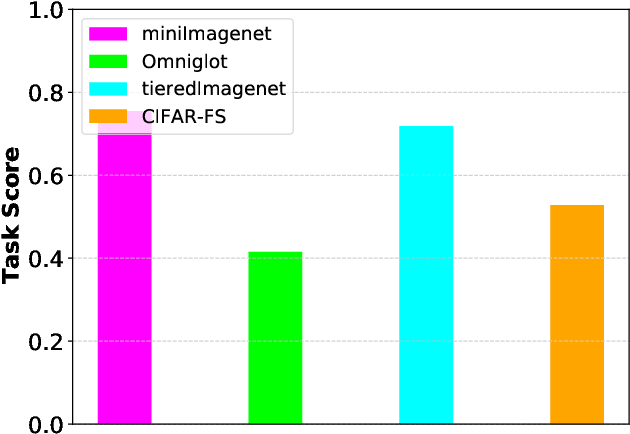

Abstract:Humans excel at adapting perceptions and actions to diverse environments, enabling efficient interaction with the external world. This adaptive capability relies on the biological nervous system (BNS), which activates different brain regions for distinct tasks. Meta-learning similarly trains machines to handle multiple tasks but relies on a fixed network structure, not as flexible as BNS. To investigate the role of flexible network structure (FNS) in meta-learning, we conduct extensive empirical and theoretical analyses, finding that model performance is tied to structure, with no universally optimal pattern across tasks. This reveals the crucial role of FNS in meta-learning, ensuring meta-learning to generate the optimal structure for each task, thereby maximizing the performance and learning efficiency of meta-learning. Motivated by this insight, we propose to define, measure, and model FNS in meta-learning. First, we define that an effective FNS should possess frugality, plasticity, and sensitivity. Then, to quantify FNS in practice, we present three measurements for these properties, collectively forming the \emph{structure constraint} with theoretical supports. Building on this, we finally propose Neuromodulated Meta-Learning (NeuronML) to model FNS in meta-learning. It utilizes bi-level optimization to update both weights and structure with the structure constraint. Extensive theoretical and empirical evaluations demonstrate the effectiveness of NeuronML on various tasks. Code is publicly available at \href{https://github.com/WangJingyao07/NeuronML}{https://github.com/WangJingyao07/NeuronML}.
 Add to Chrome
Add to Chrome Add to Firefox
Add to Firefox Add to Edge
Add to Edge